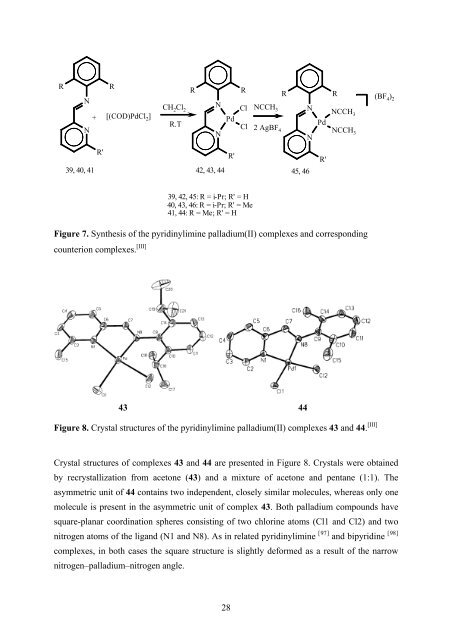As a PDF file - E-thesis - Helsinki.fi
As a PDF file - E-thesis - Helsinki.fi
As a PDF file - E-thesis - Helsinki.fi
You also want an ePaper? Increase the reach of your titles
YUMPU automatically turns print PDFs into web optimized ePapers that Google loves.
R<br />
R<br />
N<br />
+ [(COD)PdCl 2 ]<br />
N<br />
CH 2 Cl 2<br />
R.T<br />
R<br />
N<br />
N<br />
Pd<br />
R<br />
Cl<br />
Cl<br />
R<br />
NCCH 3<br />
2 AgBF 4<br />
N<br />
N<br />
Pd<br />
R<br />
(BF 4 ) 2<br />
NCCH 3<br />
NCCH 3<br />
R'<br />
39, 40, 41<br />
R'<br />
42, 43, 44 45, 46<br />
R'<br />
39, 42, 45: R = i-Pr; R' = H<br />
40, 43, 46: R = i-Pr; R' = Me<br />
41, 44: R = Me; R' = H<br />
Figure 7. Syn<strong>thesis</strong> of the pyridinylimine palladium(II) complexes and corresponding<br />
counterion complexes. [III]<br />
43 44<br />
Figure 8. Crystal structures of the pyridinylimine palladium(II) complexes 43 and 44. [III]<br />
Crystal structures of complexes 43 and 44 are presented in Figure 8. Crystals were obtained<br />
by recrystallization from acetone (43) and a mixture of acetone and pentane (1:1). The<br />
asymmetric unit of 44 contains two independent, closely similar molecules, whereas only one<br />
molecule is present in the asymmetric unit of complex 43. Both palladium compounds have<br />
square-planar coordination spheres consisting of two chlorine atoms (Cl1 and Cl2) and two<br />
nitrogen atoms of the ligand (N1 and N8). <strong>As</strong> in related pyridinylimine [ 97]<br />
and bipyridine [ 98]<br />
complexes, in both cases the square structure is slightly deformed as a result of the narrow<br />
nitrogen–palladium–nitrogen angle.<br />
28
















